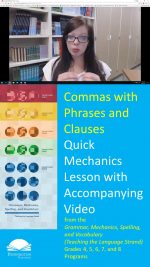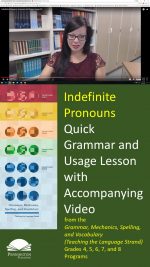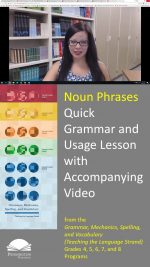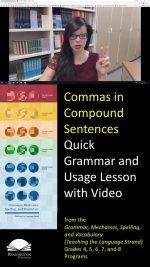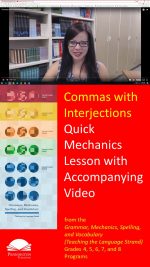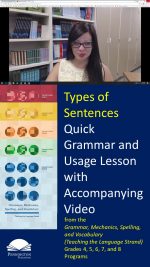How to Teach Commas with Phrases and Clauses
Commas with Phrases and Clauses
Play the quick video lesson HERE and click the upper left back arrow to return to this lesson.
Common Core Language Standard L.1
Both phrase and clauses are used as parts of sentences. Because the phrase and clause are parts, they need to be separated from the rest of the sentence. Often that separation requires punctuation. The rules vary depending upon the location of the phrase or clause within the sentence.
Today’s mechanics lesson is on commas with phrases and clauses. Remember that a phrase is a group of related words without a noun and connected verb. Display Instructional PowerPoint Slides
Now let’s read the mechanics lesson and study the examples.
Use commas to set off phrases or clauses that are separate from or interrupt the main clause of the sentence. Example: She has, if I’m not mistaken, been here before.
If an introductory phrase is four words or less, don’t follow with a comma, unless the phrase is given special emphasis. Examples: Over there I waited; Beneath the fluffy white clouds, I hiked.
Now circle or highlight what is right and revise what is wrong according to mechanics lesson.
Practice: Under the covers, she crawled after the ghost story was finished. She was scared, but not terrified by the spiders.
Let’s check the Practice Answers.
Mechanics Practice Answers: Under the covers she crawled after the ghost story was finished. She was scared, but not terrified by the spiders.
Now let’s apply what we have learned.
Writing Application: Write your own sentence using an introductory phrase.
*****

Pennington Publishing Grammar Programs
Teaching Grammar, Usage, and Mechanics (Grades 4, 5, 6, 7, 8, and High School) are full-year, traditional, grade-level grammar, usage, and mechanics programs with plenty of remedial practice to help students catch up while they keep up with grade-level standards. Twice-per-week, 30-minute, no prep lessons in print or interactive Google slides with a fun secret agent theme. Simple sentence diagrams, mentor texts, video lessons, sentence dictations. Plenty of practice in the writing context. Includes biweekly tests and a final exam.
Grammar, Usage, and Mechanics Interactive Notebook (Grades 4‒8) is a full-year, no prep interactive notebook without all the mess. Twice-per-week, 30-minute, no prep grammar, usage, and mechanics lessons, formatted in Cornell Notes with cartoon response, writing application, 3D graphic organizers (easy cut and paste foldables), and great resource links. No need to create a teacher INB for student make-up work—it’s done for you! Plus, get remedial worksheets, biweekly tests, and a final exam.
Syntax in Reading and Writing is a function-based, sentence-level syntax program, designed to build reading comprehension and increase writing sophistication. The 18 parts of speech, phrases, and clauses lessons are each leveled from basic (elementary) to advanced (middle and high school) and feature 5 lesson components (10–15 minutes each): 1. Learn It! 2. Identify It! 3. Explain It! (analysis of challenging sentences) 4. Revise It! (kernel sentences, sentence expansion, syntactic manipulation) 5. Create It! (Short writing application with the syntactic focus in different genre).
Get the Diagnostic Grammar, Usage, and Mechanics Assessments, Matrix, and Final Exam FREE Resource:
![]()
